#Indigenous populations
Explore tagged Tumblr posts
Text
How the world’s favorite conservation model was built on colonial violence | Grist
On a 1919 trip to the United States, King Albert I of Belgium visited three of the country’s national parks: Yellowstone, Yosemite, and the newly established Grand Canyon. The parks represented a model developed by the U.S. of creating protected national parks, where visitors and scientists could come to admire spectacular, unchanging natural beauty and wildlife. Impressed by the parks, King Albert created his own just a few years later: Albert National Park in the Belgian Congo, established in 1925.
Widely seen as the first national park in Africa, Albert National Park (now called Virunga National Park), was designed to be a place for scientific exploration and discovery, particularly around mountain gorillas. It also set the tone for decades of colonial protected parks in Africa. Although Belgian authorities claimed that the park was home to only a small group of Indigenous people — “300 or so, whom we like to preserve” — they violently expelled thousands of other Indigenous people from the area. The few hundred selected to remain in the park were seen as a valuable addition to the park’s wildlife rather than as actual people.
And so modern conservation in Africa began by separating nature from the people who lived in it. Since then, as the model has spread across the globe, inhabited protected areas have routinely led to the eviction of Indigenous peoples. Today, these conservation projects are led not by colonial governments but by nonprofit executives, large corporations, academics, and world leaders.

For much of human history, most people lived in rural areas, surrounded by nature and farmland. That all changed with the Industrial Revolution. By the end of the 19th century, European forests were vanishing, cities were growing, and Europeans felt increasingly disconnected from the natural world.
“With industrialization, the link with the natural cycle of things got lost — and that also led to a certain type of romanticization of nature, and a longing for a particular type of nature,” said Bram Büscher, a sociologist at Wageningen University in the Netherlands.
In Africa, Europeans could experience that pure, untouched nature, even if it meant expelling the people living on it.
“The idea that land is best preserved when it’s protected away from humans is an imperialist ideology that has been imposed on Africans and other Indigenous people,” said Aby Sène-Harper, an environmental social scientist at Clemson University in South Carolina.
For Europeans, creating protected parks in Africa allowed them to expand their dominion over the continent and quench their thirst for “undisturbed” nature, all without threatening their ongoing expansion of industrialization and capitalism in their own countries. With each new national park came more evictions of Indigenous people, paving the way for trophy hunting, resource extraction, and anything else they wanted to do.

In the mid-19th century, European colonization of Africa was limited, largely confined to coastal regions. But by 1925, when King Albert created his park, Europeans controlled roughly 90 percent of the continent.
At the time, these parks were playgrounds for wealthy Europeans and part of a massive imperial campaign to control African land and resources. Today, there are thousands of protected national parks around the world covering millions of acres, ranging from small enclosures like Gateway Arch National Park in St. Louis to sprawling landmarks like Death Valley in California and Kruger National Park in South Africa. And the world wants more.
Scientists, politicians, and conservationists are championing the protected-areas model, developed in the U.S. and perfected in Africa. In late 2022, at the United Nations Biodiversity Conference in Montreal, nearly 200 countries signed an international pledge to protect 30 percent of the world’s land and waters by 2030, an effort known as 30×30 that would amount to the greatest expansion of protected areas in history.
So how did protected parks move from an imperial tool to an international solution for accelerating climate and biodiversity crises?
In the early part of the 20th century, the expansion of colonial conservation areas was humming along. From South Africa to Kenya and India, colonial governments were creating protected national parks. These parks provided a host of benefits to their creators. There were economic benefits, including extraction of resources on park land and tourism income from increasingly popular safaris and hunting expeditions. But most of all, the rapidly developing network of parks was a form of control.
“If you can sweep a lot of peasants and Indigenous peoples away from the lands, then it’s easier to colonize the land,” Büscher said.
This approach was enshrined by the 1933 International Conference for the Protection of the Fauna and Flora of Africa, which created one of the first international treaties, known as the London Convention, to protect wildlife. The convention was led by prominent trophy hunters, but it recommended that colonies restrict traditional African hunting practices.
“Conservation is an ideology. And this ideology is based on the idea that other human beings’ ways of life are wrong and are harming nature, that nature needs no human beings in order to be saved,” said Fiore Longo, a researcher and campaigner at Survival international, a nonprofit that advocates for Indigenous rights globally.
The London Convention also suggested national parks as a primary solution to preserve nature in Africa — and as many African countries saw the creation of their first national parks in the first half of the 20th century, the removal of Indigenous peoples continued. The convention was also an early sign that conservation was becoming a global task, rather than a collection of individual projects and parks.
This sense of collective responsibility only grew in the aftermath of World War II, when many international organizations and mechanisms, like the United Nations, were created, ushering in a new period of global cooperation. In 1948, the International Union for Conservation of Nature, or IUCN, the world’s first international organization devoted to nature conservation, was established. This would help pave the way for a new phase of international conservation trends.
By the middle of the 20th century, many countries in Africa were beginning to decolonize, becoming independent from the European powers that had controlled them for decades. Even as they lost their colonies, the imperial powers were not willing to let go of their protected parks. But at the same time, the IUCN was proving ineffective and underfunded. So in 1961, the World Wildlife Fund, or WWF, an international nonprofit, was founded by European conservationists to help fund global efforts to protect wildlife.
Sène-Harper said that although the newly independent African countries nominally controlled their national parks, many of them were run or supported by Western nonprofits like WWF.
“They’re trying to find more crafty ways to be able to extract without seeming so colonial about it, but it’s still an imperialist form of invasion,” she said.
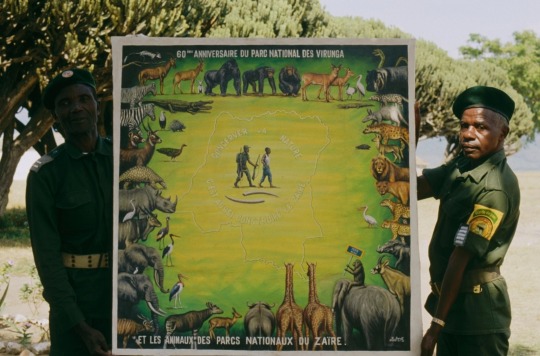
Although these nonprofits have done important work in raising awareness of the extinction crisis, and have had some successes, experts say that the model of colonial conservation has not changed and has only made the problem worse.
Over the years, WWF and other nonprofits have helped fund violent campaigns against Indigenous peoples, from Nepal to the Democratic Republic of the Congo. And amid it all, climate change continues to worsen and species continue to suffer.
In 2019, in response to allegations about murders and other human rights abuses, WWF conducted an independent review that found “no evidence that WWF staff directed, participated in, or encouraged any abuses.” The organization also said in a statement that “We feel deep and unreserved sorrow for those who have suffered. We are determined to do more to make communities’ voices heard, to have their rights respected, and to consistently advocate for governments to uphold their human rights obligations.”
“I think most of [the big NGOs] have become part of the problem rather than the solution, unfortunately,” Büscher said. “The extinction crisis is very real and urgent. But, nonetheless, the history of these organizations and their policies are incredibly contradictory.”
To Indigenous people who had already suffered from decades of colonial conservation policies, little changed with decolonization.
“When we got independence, we kept on the same policies and regulations,” said Mathew Bukhi Mabele, a conservation social scientist at the University of Dodoma in central Tanzania.
In 1992, representatives from around the world gathered in Rio De Janeiro for the United Nations Conference on Environment and Development. The Earth Summit, as it has come to be known, led to the creation of the United Nations Framework Convention on Climate Change as well as the Convention on Biological Diversity, two international treaties that committed to tackling climate change, biodiversity, and sustainable development.
Biodiversity is the umbrella term for all forms of life on Earth including plants, animals, bacteria, and fungi.
Although the Earth Summit was a pivotal moment in the global fight to protect the environment, some have criticized the decision to split climate change and biodiversity into separate conferences.
“It doesn’t make sense, actually, to separate out the two because when you get to the ground, these are going to be the same activities, the same approaches, the same programs, the same life plans for Indigenous people,” said Jennifer Tauli Corpuz, who is Kankana-ey Igorot from the Northern Philippines and one of the lead negotiators of the International Indigenous Forum on Biodiversity.
From left: The 1992 UN Conference on Environment and Development, also known as the Earth Summit, brought together political leaders, diplomats, scientists, representatives of the media, and non-governmental organizations from 179 countries. Indigenous environmentalist Raoni Metuktire, a chief of the Kayapo people in Brazil, talks with an Earth Summit attendee.
In the years following the Earth Summit, biodiversity efforts began to lag behind climate action, Corpuz said.
Protecting animals was trendy during the early days of WWF, when images of pandas and elephants were key fundraising tactics. But as the impacts of climate change intensified, including more devastating storms, higher sea levels, and rising temperatures, biodiversity was struggling to gain as much attention.
“There were 100 times more resources being poured into climate change. It was more sexy, more charismatic, as an issue,” Corpuz said. “And now biodiversity wants a piece of the pie.”
But to get that, proponents of biodiversity needed to develop initiatives similar to the big goals coming out of climate conferences. For many conservation groups and scientists, the obvious solution was to fall back on what they had always done: create protected areas.
This time, however, they needed a global plan, so scientists were trying to calculate how much of the world they needed to protect. In 2010, nations set a goal of conserving 17 percent of the world’s land by 2020. Some scientists have supported protecting half the earth. Meanwhile, Indigenous groups have proposed protecting 80 percent of the Amazon by 2025.
How the world arrived at the 30×30 conservation model
Explore key moments in conservation’s global legacy, from the United States’ first national park in the 19th century to the expansion of colonial conservation areas in the early 20th century and the current push to protect 30 percent of the world’s land and oceans by 2030.
1872: Yellowstone becomes the first national park in the U.S.
1919: King Albert I of Belgium tours Yellowstone, Yosemite, and the Grand Canyon
1925: Albert National Park is established in the Belgian Congo
1933: One of the first international treaties to protect wildlife, known as the London Convention, is created by European conservationists
1948: The International Union for Conservation of Nature (IUCN) is established
1961: The World Wildlife Fund, a non-governmental organization, is founded by European conservationist
1992: The Earth Summit in Brazil creates the Convention on Biological Diversity (CBD)
2010: CBD sets a goal of conserving 17% of the world’s land by 2020
2022: At the UN Biodiversity Conference, nearly 200 countries set 30×30 as an international goal
In 2019, Eric Dinerstein, formerly the chief scientist at WWF, and others wrote the Global Deal for Nature, a paper that proposed formally protecting 30 percent of the world by 2030 and 50 percent by 2050, calling it a “companion pact to the Paris Agreement.” Their 30×30 plan has since gained widespread international support.
But other experts, including some Indigenous leaders, say the idea ignores generations of effective Indigenous land management. At the time, there was limited scientific attention paid to Indigenous stewardship. Because of that, Indigenous leaders say they were largely ignored in the early years of international biodiversity negotiations.
“At the moment, we did not have a lot of evidence,” said Viviana Figueroa, who is Omaguaca-Kolla from Argentina and a member of the International Indigenous Forum on Biodiversity.
Some experts see the push for global protected areas as a direct response to community-based conservation, which grew in popularity in the 1980s, and saw local communities and Indigenous peoples take control of conservation projects in their area, rather than the centralized approach that had dominated during colonial times.

Some of the chief proponents of 30×30 bristle at the suggestion that they do not support Indigenous rights and say that Indigenous land management is at the heart of the initiative.
In response to a request for comment, a spokesperson from WWF pointed to its website, which outlines the organization’s approach to area-based conservation and its position on 30×30: “WWF supports the inclusion of a ‘30×30’ target in CBD’s post-2020 global biodiversity framework (GBF) only if certain conditions are met. For example, such a target must ensure social equity, good governance, and an inclusive approach that secures the rights of Indigenous peoples and local communities to their land, freshwater, and seas.”
“People have cherry-picked a few examples of where the rights of locals have been tread upon. But by and large, in the vast majority of situations, what’s going on is support of local communities, really, rather than anything to do with violation,” said Dinerstein, who now works at Resolve, a Washington, D.C.-based nonprofit focused on environmental, social, and health issues.
But Indigenous advocates say if that were true, they would not keep pushing a model that has already led to countless human rights violations.
“Despite having this knowledge and knowing that people who are not contributing to the destruction of the environment are going to pay for these protected areas, they decided to keep on pushing the target,” Survival International’s Longo said.
The new 30×30 framework agreed to by nearly 200 countries at the UN Biodiversity Conference in December came after years of delay and fierce negotiation. The challenge is now implementing the agreement around the world, a massive task that will require buy-in from individual countries and their governments.
“What was adopted in Montreal is hugely ambitious. And it can only be achieved by a lot of hard work on the ground. And it’s a great document, but it is only a document,” said David Cooper, acting executive secretary of the UN’s Secretariat of the Convention on Biological Diversity.
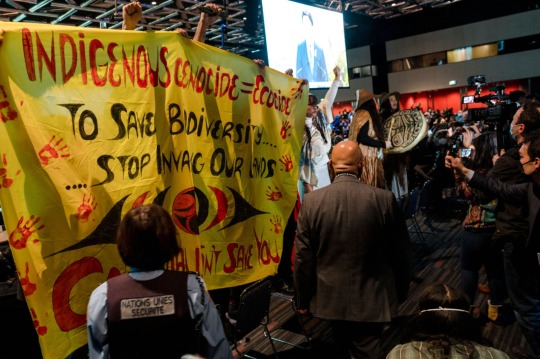
Part of that work is figuring out what land to protect. And although Indigenous negotiators and advocates did manage to get language that enshrines Indigenous rights into the final agreement, they are still concerned. Over a century of colonial conservation has shown that it only serves the powerful at the expense of Indigenous peoples.
“European countries are not going to evict white people from their lands,” said Longo. “That is for sure. This is where you see all the racism around this. Because they know how these targets will be applied in Africa and Asia. That’s what’s going on, they are evicting the people.”
Dinerstein, however, would argue that European countries have less natural resources to preserve, but more financial resources to help other countries.
“There’s a lot that can be done in Europe,” he said. “So we shouldn’t overlook that as well. I’m just making the point that there’s the opportunity to be able to do much more in other countries that have much less resources.”
Cooper said that in addition to implementation, monitoring and ensuring that rights are upheld will be a crucial task over the next seven years. “There will need to be a lot of work on monitoring. There’s always a justified nervousness that any global process cannot really see what’s happening at the local level and can end up with supporting measures that are perhaps not beneficial at the local level,” he said.
Although Indigenous leaders are going to keep fighting to ensure that the expansion of protected areas does not lead to continued violation of their rights, they are worried that the model itself is flawed. “It’s inevitable that the burden is going to fall again on developing countries,” Corpuz said.
#colonial violence#languages#How the world’s favorite conservation model was built on colonial violence#colonialism#brazil#indigenous populations#Yanomami#bolsanaro#the amazon#amazon rainforest#natural resources#ecology
31 notes
·
View notes
Text
Story of the Tennessee Agricultural Museum
I love history and learning the story behind the story! Thanks to friend and tractor collector Buddy Woodson for the invite to the Spring-Crank Up 2024, antique tractor show. During our visit to the show, and Tennessee Agricultural Museum, Buddy gave me a tour of the grounds of the Tennessee Department of Agriculture. Since then, I have been diving deep, and learning about the history of this…

View On WordPress
#American Revolution#Andrew Ewing#Bank of Tennessee#Big Salt Springs#Buddy Woodson#Buford Ellington#cabins#Caldwell & Co.#Caldwell Bank#Caldwell Mansion#cattle#Cherokee#Chicasaw#Dr. Laura Guttormson#Ellington Agricultural Center#Farmall#French Lick#Gov. Ellington#history#horse barn#hosre racing#indigenous populations#J.P. Morgan of the South#land grants#Margaret Trousdale aldwell#Music#Nashville Tennessee#North Carolina#Oscar L. Farris#Revolutionary War
3 notes
·
View notes
Text
First contact
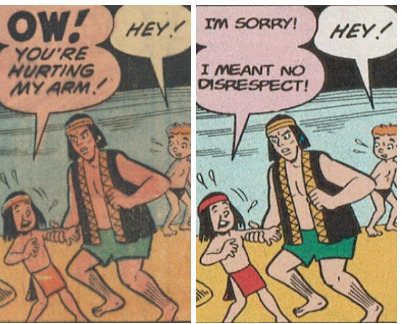
Little Mr. Lodge leads the Little Archie gang Gand gets stranded on a tropical island, where they encounter the Noble Savage trope. But this civilization no longer grabs their children's arms with so much force to cause physical hurt.
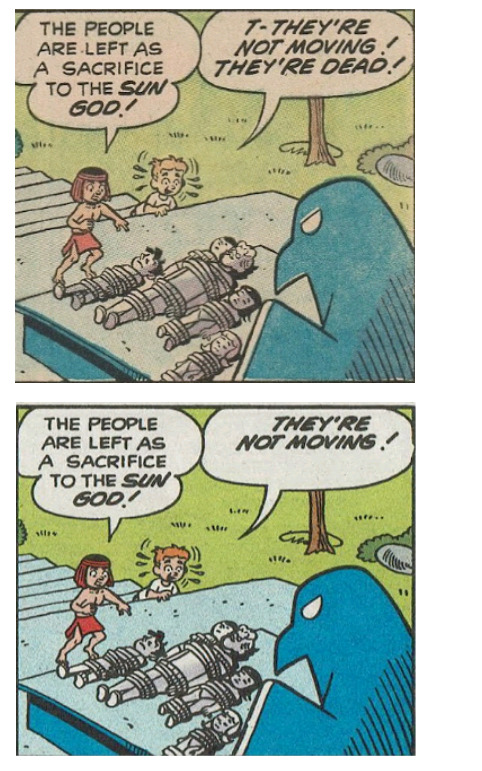
Also when they sacrifice visitors to the Sun God, they stop short of seeming to have already killed everyone.

Who is more scared?
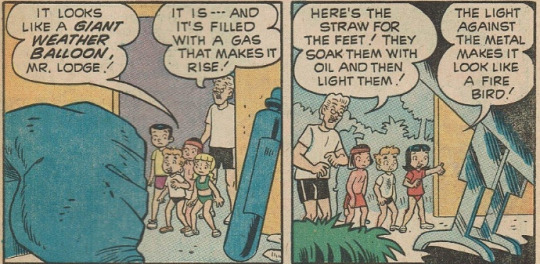
Usual conman technology.
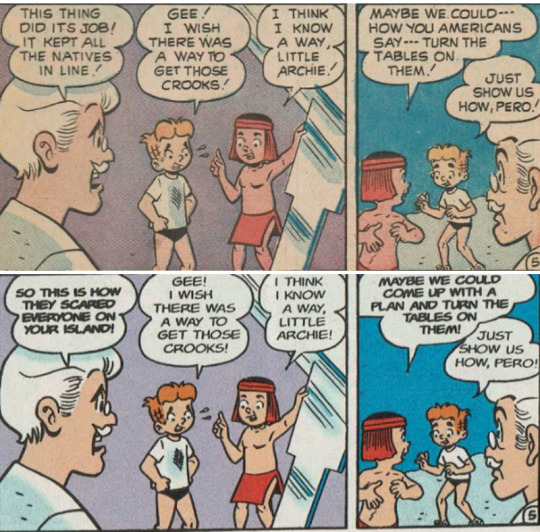
"Natives" out. For that matter so is "Americans".

This is an odd choice for new ending, and not especially depicted in the picture. I guess they do not want to leave this civilization stranded in our (Little Archie) universe, so enter the Brigadoon device.

You tell me.
#Archie Comics#Little Archie#Little Jughead#Little Veronica#Mr. Lodge#Mysterious island#Shipwrecked#Sun God#Human sacrifice#Little Betty#Little Reggie#Indigenous populations#Dexter Taylor#1973
5 notes
·
View notes
Text
Podcast Episode 14!
Nella puntata numero 14 troverete notizie sulla relazione tra uomo e biodiversità, nuove tattiche riproduttive del cervo volante e scoperte sulla locomozione dei dinosauri. Potete ascoltare il podcast gratuitamente su tutte le principali piattaforme di streaming.
In episode 14, you’ll find insights on the relationship between humans and biodiversity, new reproductive tactics of stag beetles, and discoveries about dinosaur locomotion. You can listen to the podcast for free on all major streaming platforms.
En el episodio 14 encontrarás novedades sobre la relación entre el ser humano y la biodiversidad, nuevas tácticas reproductivas del escarabajo ciervo y descubrimientos sobre la locomoción de los dinosaurios. Puedes escuchar el podcast de forma gratuita en todas las principales plataformas de streaming.

#Italiano#Drops of Science#Scienze naturali#Cervo volante#Lucanus cervus#Volo#Locomozione#Delfini#Sonar militari#Piante#Popolazioni indigene#Politiche di conservazione#Piani di conservazione#Biodiversità#Conservazione della natura#Movimento#Riproduzione#Dinosauri#Inglese#Natural sciences#Stag beetle#Flight#Locomotion#Dolphins#Military sonar#Plants#Indigenous populations#Conservation policies#Conservation plans#Biodiversity
1 note
·
View note
Text
Since the early days of British involvement with Zionism, Churchill sanctioned the dispossession of non-Jewish Palestinians by assuring that they have no voice in the affairs of their own land. “In the interests of the Zionist policy,” he stated in August 1921 as the government minister in charge of Britain’s colonies, “all elective institutions have so far been refused to the Arabs.”
A snapshot of Churchill’s stances on Palestine and race is found in the records of the 1937 Peel Commission hearings, convened to address a major revolt in Palestine. [...]
Horace Rumbold [...] asked whether Zionist policy is worth “the lives of our men, and so on.” And did it follow, he asked Churchill, that having “conquered Palestine we can dispose of it as we like?”
Churchill replied to that and similar questions by invoking commitments given when Britain captured Palestine toward the end of 1917. “We decided in the process of conquest of [Palestine] to make certain pledges to the Jews,” Churchill said.
Apparently skeptical, the head of the commission, William Peel, asked Churchill if it is not “a very odd self-government” when “it is only when the Jews are a majority that we can have it.”
Churchill responded with a blunt argument of might: “We have every right to strike hard in support of our authority.”
The historian Reginald Coupland nonetheless told the hearings that the “average Englishman” would wonder why the Arabs were being denied self-government, and why we had “to go on shooting the Arabs down because of keeping his promise to the Jews.”
Peel, similarly, asked Churchill if the British public “might get rather tired and rather inquisitive if every two or three years there was a sort of campaign against the Arabs and we sent out troops and shot them down? They would begin to enquire, ‘Why is it done? What is the fault of these people?… Why are you doing it? In order to get a home for the Jews?’”
“And it would mean rather brutal methods,” added Laurie Hammond, who had worked with the British colonial administration in India. “I do not say the methods of the Italians at Addis Ababa,” referring to Benito Mussolini’s Ethiopian massacre of February 1937, “but it would mean the blowing up of villages and that sort of thing?” The British, he recalled, had blown up part of the Palestinian port city of Jaffa.
Peel agreed, and added that “they blew up a lot of [Palestinian] houses all over the place in order to awe the population. I have seen photographs of these things going up in the air.”
But when Peel questioned whether “it is not only a question of being strong enough,” but of “downing” the Arabs who simply wanted to remain in their own country, Churchill lost patience.
“I do not admit that the dog in the manger has the final right to the manger,” he countered, “even though he may have lain there for a very long time.” He denied that “a great wrong has been done to the Red Indians of America, or the Black people of Australia,” by their replacement with “a higher grade race.”
#churchill explicitly compared what was being done to palestinians as equivalent to what was done to indigenous populations in aus and us#heard it on the podcast episode and looked it up#zionism#palestine
1K notes
·
View notes
Text
if you believe all “colonizers” should be killed…i hate to tell you this, but arabs are not the indigenous population of the levant. they got there through, guess what, conquering and colonization. so what, by your logic, they should be killed?
i’m not saying it, nor is it my logic. however, a whole lot of you ARE saying it when it comes to groups you happen to hate, like jews, who are the indigenous population of israel and judea. it IS your logic. and why?
none of you even know who the actual colonizers are in this conflict. if you did, you would not be screaming for them to be murdered. you’re already claiming a war is a genocide.
please grow a fucking braincell.
#arabs should not be killed for living outside of arabia#and the INDIGENOUS POPULATIONS OF THE LEVANT aka jews and others should not be murdered for MOVING BACK TO THEIR LAND#or continuously existing on their land#dumbassery#jumblr#antisemitism#israel#hamas#palestine#also? it’s a war not a genocide
224 notes
·
View notes
Text
Playing in stars and time, then coming to the conclusion that the forgotten country is any English majority speaking country is like just wild to me. You looked at a storyline of the crushing trauma cultural erasure and thought "this must be the UK".
#Isat spoilers#I guess#This sounds angry but I'm really just disappointed...#Post inspired by a fic where the guess was Canada and it really got me. It's not even an island...#If you simply must make the country an English speaking one at least base it on thier indigenous populations#English culture has never been under any threat of being erased.
190 notes
·
View notes
Photo
well isn't that nothing but a Palestine/Bantustan/US reservation system?

Map showing indigenous population and recognized indigenous lands in Brazil.
#trolleng#trolledu#speaking#reading#apartheid#palestine#bantustan#bantustans#brazil#indigenous population#indigenous people#indigenous populations
86 notes
·
View notes
Text

Thinking about her the other day
#navii art#my art#sth fanart#archie sonic#lupe the wolf#satam sonic#for my design i want to explore first how i would draw her as seen in the comics/show#then how i can incorporate more representative elements of her inspiration- buckskin textiles and patterns from her armor in the comics#then finally what i think would be 'easier' to draw in a comic setting- simpler design and shapes that takes less time and fits modern style#i primarily used mescalero apache peoples as reference- esp their buckskin textiles but also included patterns from her armor in the comics#she and the wolf pack were more of a monolithic representation of indigenous peoples in the americas then representing a specific population#though her armor always threw me off- maybe a mix between greek and mesoamerican? made me think too much of an amazonian warrior#and away with the leotards
22 notes
·
View notes
Text










via learn4artsakh (instagram)
#armenia#palestine#sometimes i forget that people outside my social and online circles don't know about this stuff#renaming cities villages geographical sites etc is an extremely common colonization and genocide tactic#wipe out the indigenous population -> rename everything so it seems like the people have never even existed ->#claim their culture history and land as your own.#evil and vile#i thought someone may find these infographics useful/learn smth new#and follow learn4artsakh acc (and check out their e-library!!!!!) if you use insta. educate yourself!!
22 notes
·
View notes
Text
THAT WAS DUNE???? THAT WAS JUST A QUIRKED UP WHITE BOY DOING SO MANY DRUGS HE BECOMES JESUS
#I finished Dune can you tell#So it's a pretty good analysis of ecology and colonization and white savior complexes#Except I like that Paul literally can't run from his destiny as a white savior. No matter what he tries to do to stop the Holy War#the loyalty of his followers ALONE is what will cause it!#He can do the most ordinary things a 18 year old boy is capable of with some added psychics and it will be sanctified#because of the Bene Gesserit manipulating the indigenous population into seeing Godhood in everything their perceived messiah does!#When he says “I didn't even draw my knife but it will be said of this day that I slew twenty Sardaukar by my own hand”#“I cannot do the simplest thing without its becoming a legend. They will mark how I parted from Chani#how I greet Stilgar-- every move I make this day. Live or die it is a legend. I must not die.#Then it will only be legend and nothing to stop the jihad.“#And “I have seen a friend become a worshipper”#goddddd hes trying so hard to escape his fate but his cult are so loyal to him his fate will come no matter what he does#dune
96 notes
·
View notes
Text
“why would elaena marry a dornishman when they’re nasty evil people who murdered her poor innocent brother daeron”
maybe because once elaena grew up she realized that there were better ways of bringing dorne into the realm than violent conquest, and that daeron got the death he deserved from not just a nobility that is valid for fearing subjugation from valyria but also a smallfolk sick and tired of these people showing up every few decades to set their principality on fire, and put aside any anti dornish sentiments she may or may not have harbored as a child to see the way her family had directly attributed to their suffering, eventually even falling in love with and marrying a dornish man??
also, considering daeron ii attempts a type of proto-reparations act in bringing dorne into the kingdom, it’s not out of the realm of possibility that someone as intelligent as elaena would recognize the inherent racism in the targaryen conquest of dorne and especially considering the very loud anti-dornish, deeply anti intellectual faction in the blackfyre rebellions, realized they wouldn’t be kind or understanding of an intelligent woman like herself and had no interest in herself or her daughters (of which she had four!!) getting shoved back into the maidenvault again?
like, daeron i is on some andrew jackson manifest destiny shit, and if it makes me an asshole for thinking “god i wish someone had merked jackson before he genocided & displaced my ancestors, good on the dornish for realizing you can’t negotiate with imperialists” than i am perfectly comfortable being considered an asshole right next to my girl elaena.
#everyone discoursing about the young dragon. listen. they should have tortured him before they killed him too.#anti daeron i targaryen#valyrianscrolls#anti house targaryen#idk just in case. clearly i’m not anti everyone i’m complimenting elaena & daeron ii#elaena targaryen#daeron the good#daeron ii targaryen#getting on my soap box#dorne#also when i say ‘my ancestors’ i mean that jackson passed the indian removal act specifically to remove my tribe (and several others) bc#white people in the midwest didn’t like that we wouldn’t leave.#my tribe managed to work somethjng out and only had to move a couple miles away from our homelands. others in our area were forcibly mkced#*moved. look up the potawatomi trail of death. they marched them thru illinois’ capital. dozens including children died.#also read about the fort dearborn massacre. and rising up from indian country which makes the argument that it wasn’t a massacre#but a battle bc white americans had been raiding potawatomi villages for weeks. so the potawatomi struck back and people to this day insist#it was a massacre just bc the potawatomi were better at fighting than the americans. nah.#u don’t get to wage a war of conquest on an innocent and indigenous population just to turn around and say they were mean for fighting back.#i’m sorry i woke up today and decided to choose violence. i’m in an awful mood aksjdjd
135 notes
·
View notes
Text
everything the state of Israel has done and that leftists claim it has done has been done by the USA tenfold. but you don't hear people call to wipe America off the map, do you? you don't hear people cheering for the deaths of Americans, do you? I wonder why that is.
#for american leftists israel is a way to deal with their colonial guilt without suffering the consequences themselves#“death to the other colonizers! just not us please :)”#plus even if ashkenazi israelis are actually colonizers that still makes over half of the israeli population indigenous regardless#when are we going to sit down and have the talk that literally so many countries in history were built on colonialism#especially arab countries which the left loves oh-so very much#leftist antisemitism#antisemitism#israel#i/p#jumblr#hila has spoken
29 notes
·
View notes
Text
Lotta people on this website get a big kick out of yelling "PUNCH NAZIS!!1!!" and it's like. Babe. You are the Nazi.
Like if you see the brutal murders of literal children as "sad" but justified because civilian Jews are "invaders" who "don't belong"....I have some news for you about what you would have been doing in 1940s Germany.
#gingerswagfreckles#israel#palestine#like you guys are psychopaths lol. palestine has the right to defend itself but what hamas is doing is not#self defense#and not justified under any circumstances#and if you think otherwise#than u have already done 3/4ths of the mental gymnastics the nazis had to convince the German people of#to convince them that murdering an entire population was fine#like the jews werent indigenous to germany either u know. lol.#the way u guys talk about the concept of being indigenous to somewhere is kind of fucking insane#there r no circumstances in which mass rape and murder of civilian populations are ok#and if u do not agree wjth that you are easily swayed into violence and evil through righteous anger and have no moral compass#hamas#israel palestine conflict
71 notes
·
View notes
Text
me: dune is an analogy for colonialism especially colonialism in the middle east.
them: what? no? it’s fantasy. in what way is it like the middle east?
me: …

#literally didn’t think I was saying something controversial#dune 2#dune#dune part 2#the spice is oil#that’s all you need#but we could go on about the fake language#the ethnic profile of each group#the blatant imperialism#the genocide of the indigenous population#BUT YEAH WHAT AM I TALKING ABOUT
28 notes
·
View notes
Text
The federal government is planning to create a new agent of Parliament to oversee modern treaty implementation, something Prime Minister Justin Trudeau says will ensure Ottawa is held to account no matter who is in power.
He announced the plan to appoint a commissioner for modern treaty implementation Tuesday in Gatineau, Que., at the second annual meeting of self-governing Indigenous governments.
"This is a lasting commitment to be a better treaty partner," he said.
"To honour our agreements with Indigenous Peoples, we need to ensure that trust, transparency and accountability remain at the heart of our efforts to build renewed nation-to-nation, Inuit-Crown and government-to-government relationships." [...]
Continue Reading.
Tagging: @newsfromstolenland
#cdnpoli#Justin Trudeau#Truth and Reconciliation#Indigenous politics#annihilating 1 Indigenous population while pretending to care about another
30 notes
·
View notes